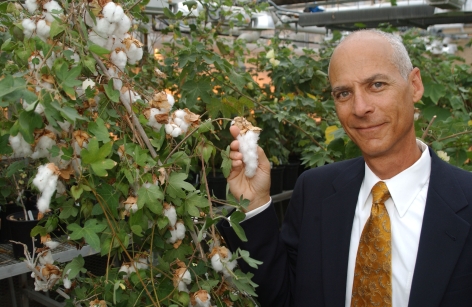
Jonathan Wendel is part of an international team of researchers who have mapped the genome of cotton. The researchers published their findings in the journal Nature this week. Larger photo. Photo courtesy of Jonathan Wendel.
AMES, Iowa – An international consortium of scientists that includes an Iowa State University professor has mapped the genome sequence for cotton in a paper published this week in the journal Nature.
The sequencing of the genome will have sweeping ramifications for cotton growers, plant biologists and producers who grow other cash crops. The publication of the genome will also produce economic benefits for consumers as well.
Jonathan Wendel, a Distinguished Professor and chair of the ISU Department of Ecology, Evolution and Organismal Biology, is the second lead author of the paper. His lab carried out much of the biology experimentation and research that went into the genome sequencing project.
Wendel specializes in the study of polyploid plants that contain more than two sets of chromosomes in their genomes. Many of the most important crops that humans have domesticated are polyploids, including cotton, wheat, soybeans, and maize. Studying how these plants evolved to contain so much chromosomal material sheds light on the fundamental nature of genetics and evolution, Wendel said.
“We’re able to focus on some of the big evolutionary and biological questions humans have been asking for a long time, and we’re able to answer some of those big questions now,” he said.
The researchers focused their efforts on Gossypium ramondii, a wild species of cotton native to a small region of Peru, and one of the progenitors of the modern polyploid cottons that are so commercially important. The study represents the first time a polyploid plant has been compared to its progenitors at a whole genome level, yielding some striking results. For instance, the paper reports that this particular variety of cotton underwent genetic doubling between 30 and 36 times throughout its history, resulting in a complex genetic structure.
Wendel said millennia of human domestication of cotton and its wide geographic dispersal across the globe yield a wealth of insight into the evolutionary process.
“This genome sequence achievement is a watershed moment in our understanding of the origin, and ultimately the function, of complex plant genomes,” he said.
Cotton production contributes substantially to economies around the globe. The value of cotton fiber grown in the United States exceeds $6 billion per year. Wendel said sequencing of the cotton genome will benefit the producers of corn and soybeans, which are also polyploid plants. He said insights gained from the cotton genome will increase understanding of the genetics of other crops and enable producers to increase yields and combat disease and pests.
The paper lists 74 co-authors representing 31 institutions. The consortium was led by Andrew Paterson of the University of Georgia. Ten of the paper’s co-authors work, or recently worked in Wendel’s lab at Iowa State University. ISU researchers have been pursuing cotton genomics for about 25 years because of its importance to our understanding of evolutionary biology, Wendel said.